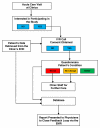Closing the feedback loop: an interactive voice response system to provide follow-up and feedback in primary care settings
- PMID: 23340825
- PMCID: PMC3662799
- DOI: 10.1007/s10916-012-9905-4
Closing the feedback loop: an interactive voice response system to provide follow-up and feedback in primary care settings
Abstract
In primary care settings, follow-up regarding the outcome of acute outpatient visits is largely absent. We sought to develop an automated interactive voice response system (IVRS) for patient follow-up with feedback to providers capable of interfacing with multiple pre-existing electronic medical records (EMRs). A system was designed to extract data from EMRs, integrate with the IVRS, call patients for follow-up, and provide a feedback report to providers. Challenges during the development process were analyzed and summarized. The components of the technological solution and details of its implementation are reported. Lessons learned include: (1) Modular utilization of system components is often needed to adapt to specific clinic workflow and patient population needs (2) Understanding the local telephony environment greatly impacts development and is critical to success, and (3) Ample time for development of the IVRS questionnaire (mapping all branching paths) and speech recognition tuning (sensitivity, use of barge-in tuning, use of "known voice") is needed. With proper attention to design and development, modular follow-up and feedback systems can be integrated into existing EMR systems providing the benefits of IVRS follow-up to patients and providers across diverse practice settings.
Figures
Similar articles
-
Exploration of an automated approach for receiving patient feedback after outpatient acute care visits.J Gen Intern Med. 2014 Aug;29(8):1105-12. doi: 10.1007/s11606-014-2783-3. Epub 2014 Mar 8. J Gen Intern Med. 2014. PMID: 24610308 Free PMC article.
-
Lessons and pitfalls of interactive voice response in medical research.Contemp Clin Trials. 2007 Sep;28(5):593-602. doi: 10.1016/j.cct.2007.02.007. Epub 2007 Mar 3. Contemp Clin Trials. 2007. PMID: 17400520
-
Automated patient assessments after outpatient surgery using an interactive voice response system.Am J Manag Care. 2008 Jul;14(7):429-36. Am J Manag Care. 2008. PMID: 18611094
-
Interactive voice response systems for improving delivery of ambulatory care.Am J Manag Care. 2009 Jun;15(6):383-91. Am J Manag Care. 2009. PMID: 19514804 Review.
-
Usability and Safety in Electronic Medical Records Interface Design: A Review of Recent Literature and Guideline Formulation.Hum Factors. 2015 Aug;57(5):805-34. doi: 10.1177/0018720815576827. Epub 2015 Mar 23. Hum Factors. 2015. PMID: 25850118 Review.
Cited by
-
Resurgence of Measles in Europe: A Systematic Review on Parental Attitudes and Beliefs of Measles Vaccine.J Epidemiol Glob Health. 2020 Mar;10(1):46-58. doi: 10.2991/jegh.k.191117.001. J Epidemiol Glob Health. 2020. PMID: 32175710 Free PMC article.
-
The E-Coach technology-assisted care transition system: a pragmatic randomized trial.Transl Behav Med. 2016 Sep;6(3):428-37. doi: 10.1007/s13142-016-0422-8. Transl Behav Med. 2016. PMID: 27339715 Free PMC article. Clinical Trial.
-
Telephone follow-up in primary care: can interactive voice response calls work?Stud Health Technol Inform. 2013;192:112-6. Stud Health Technol Inform. 2013. PMID: 23920526 Free PMC article.
-
Smartphone Application WeChat for Clinical Follow-up of Discharged Patients with Head and Neck Tumors: A Randomized Controlled Trial.Chin Med J (Engl). 2016 Dec 5;129(23):2816-2823. doi: 10.4103/0366-6999.194635. Chin Med J (Engl). 2016. PMID: 27900995 Free PMC article. Clinical Trial.
-
Use of health information technology to reduce diagnostic errors.BMJ Qual Saf. 2013 Oct;22 Suppl 2(Suppl 2):ii40-ii51. doi: 10.1136/bmjqs-2013-001884. Epub 2013 Jul 13. BMJ Qual Saf. 2013. PMID: 23852973 Free PMC article. Review.
References
-
- Fewer bells and whistles, but IVR (interactive voice response) gets the job done. Dis. Manag. Advis. 2001;7(9):129–133. [No authors listed] - PubMed
-
- Abu-Hasaballah K, James A, Aseltine RH., Jr. Lessons and pitfalls of interactive voice response in medical research. Contemp. Clin. Trials. 2007;28(5):593–602. - PubMed
-
- Oake N, Jennings A, van Walraven C, Forster AJ. Interactive voice response systems for improving delivery of ambulatory care. Am. J. Manag. Care. 2009;15(6):383–391. - PubMed
-
- Pierce G. IVR (interactive voice response) me ASAP. Four hot applications of interactive voice response. Healthc. Inform. 1998;15(2):147–148. 150, 152. - PubMed
-
- Schroder KE, Johnson CJ. Interactive voice response technology to measure HIV-related behavior. Curr. HIV/AIDS Rep. 2009;6(4):210–216. - PubMed
Publication types
MeSH terms
Grants and funding
LinkOut - more resources
Full Text Sources
Other Literature Sources
Miscellaneous



